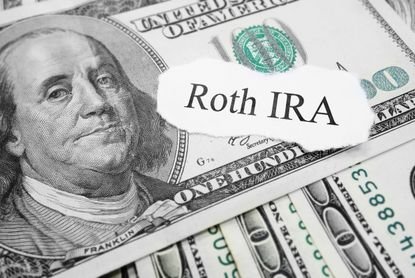How to Open a Roth IRA in Five Simple Steps
Here's what you need to know in order to easily open a Roth IRA.


Are you looking to open a Roth IRA to let your money grow tax-free? Roth IRAs are individual retirement accounts that let you save for retirement with after-tax dollars. Since taxes are paid on contributions before they’re placed in the account, withdrawals from a Roth IRA can be made tax-free at a later date. And since the IRS has increased contribution limits on Roth IRAs for 2024, you can save even more than in previous years.
Here’s how to open a Roth IRA in five simple steps.
1. Make sure you're eligible to open a Roth IRA
The first step in opening a Roth IRA is determining if you’re eligible. In order to be eligible for a Roth IRA, you’ll need to have earned income, and this income must be within certain limits.

Sign up for Kiplinger’s Free E-Newsletters
Profit and prosper with the best of expert advice on investing, taxes, retirement, personal finance and more - straight to your e-mail.
Profit and prosper with the best of expert advice - straight to your e-mail.
In 2024, in order to contribute the maximum amount to your Roth IRA ($7,000 or $8,000 if you are 50 or older), your income must be no more than $146,000 for single filers or $230,000 for those married filing jointly.
If your income exceeds this, your contribution limit will begin to phase out until it disappears. The phase-out range for single filers is between $146,000 and $161,000, and $230,000 and $240,000 for those married filing jointly.
If you make more than this, you could potentially benefit from using a backdoor Roth IRA, where you convert a traditional IRA to a Roth.
2. Choose a provider
Now you’ll need to choose where to open an account. Roth IRA accounts can be opened through a number of places, including mutual fund firms, full-service brokerages and financial planning firms. You can open a Roth IRA account at almost all investment companies. If you’re planning on picking your own investments, opening a Roth IRA at an online broker is a good choice. On the other hand, if you’re more of a hands-off investor, consider a robo-advisor.
When searching for Roth IRA providers, it's important to compare minimum investment requirements and maintenance fees, if any. Also consider whether or not the company offers the types of investments you’re looking for (mutual funds, ETFs, etc.), how much it costs to trade and if the account offers any additional tools like retirement calculators.
3. Fill out the paperwork
After choosing a provider, it's time to apply. In many cases, you can complete a Roth IRA application online, but you'll need to gather some paperwork in order to do so. Here's what you'll need to have on hand during the sign-up process.
- Driver's license, photo ID or passport
- Social Security number
- Bank routing number
- Checking or savings account number to transfer money to the account
- Proof of employment
- Name, address and SSN of the plan beneficiary
4. Choose investments
Next, you’ll need to choose the investments for your Roth IRA. You can choose to do this all by yourself or have an advisor do it for you. If you choose to do it yourself, you’ll need to decide on an appropriate asset allocation, based on your comfort level with risk and your time horizon to retirement. Choose how much money you’ll put towards riskier investments and how much you’ll keep relatively more safe. You can also invest in a target-date retirement fund for a simple way to maintain diversification and risk levels.
5. Set up a contribution schedule
Instead of paying in one lump sum, you can fit regular contribution payments into your budget by setting up monthly transfers from your checking or savings account to your Roth IRA. The Roth IRA contribution limit for 2024 is $7,000 (or $8,000 if you're older than 50), which works out to be around $583 a month. If you can't afford this much each month, it stills pays off to contribute what you can.
Pros and Cons of a Roth IRA
| Pros | Cons |
|---|---|
| Tax-free growth | No upfront tax break for contributing |
| No required minimum distributions (RMDs) | Income limits for making contributions |
| Contributions can be withdrawn any time, tax- and penalty-free | Earnings withdrawals before age 59 ½ may be subject to penalties |
| Tax flexibility in retirement | Ease of early withdrawals might be tempting |
| Pass down money in a Roth IRA tax-free to your heirs | Contribution limit of 7,000 (or $8,000 if you're older than 50) |
Related Content

To continue reading this article
please register for free
This is different from signing in to your print subscription
Why am I seeing this? Find out more here
Get Kiplinger Today newsletter — free
Profit and prosper with the best of Kiplinger's advice on investing, taxes, retirement, personal finance and much more. Delivered daily. Enter your email in the box and click Sign Me Up.

Erin pairs personal experience with research and is passionate about sharing personal finance advice with others. Previously, she was a freelancer focusing on the credit card side of finance, but has branched out since then to cover other aspects of personal finance. Erin is well-versed in traditional media with reporting, interviewing and research, as well as using graphic design and video and audio storytelling to share with her readers.
-
 Rent a Luxury Pool This Summer With Swimply — the Airbnb of Pools
Rent a Luxury Pool This Summer With Swimply — the Airbnb of PoolsWith Swimply, you can live it up at a luxury pool while escaping the heat and going for a swim.
By Erin Bendig Published
-
 The Secret Credit Card for Amazon Prime Day Shopping
The Secret Credit Card for Amazon Prime Day ShoppingThis "secret" credit card for Amazon Prime Day shopping can maximize your cash back rewards. Plus get a $300 bonus.
By Erin Bendig Published
-
 Medicare Basics: 11 Things You Need to Know
Medicare Basics: 11 Things You Need to KnowMedicare There's Medicare Part A, Part B, Part D, Medigap plans, Medicare Advantage plans and so on. We sort out the confusion about signing up for Medicare — and much more.
By Catherine Siskos Last updated
-
 Six of the Worst Assets to Inherit
Six of the Worst Assets to Inheritinheritance Leaving these assets to your loved ones may be more trouble than it’s worth. Here's how to avoid adding to their grief after you're gone.
By David Rodeck Published
-
 403(b) Contribution Limits for 2024
403(b) Contribution Limits for 2024retirement plans Teachers and nonprofit workers can contribute more to a 403(b) retirement plan in 2024 than they could in 2023.
By Jackie Stewart Published
-
 SEP IRA Contribution Limits for 2024
SEP IRA Contribution Limits for 2024SEP IRA A good option for small business owners, SEP IRAs allow individual annual contributions of as much as $69,000 a year.
By Jackie Stewart Last updated
-
 Roth IRA Contribution Limits for 2024
Roth IRA Contribution Limits for 2024Roth IRAs Roth IRA contribution limits have gone up for 2024. Here's what you need to know.
By Jackie Stewart Last updated
-
 SIMPLE IRA Contribution Limits for 2024
SIMPLE IRA Contribution Limits for 2024simple IRA The SIMPLE IRA contribution limit increased by $500 for 2024 and workers at small businesses can contribute up to $16,000 or $19,500 if 50 or over.
By Jackie Stewart Last updated
-
 457 Contribution Limits for 2024
457 Contribution Limits for 2024retirement plans State and local government workers can contribute more to their 457 plans in 2024 than in 2023.
By Jackie Stewart Published
-
 Roth 401(k) Contribution Limits for 2024
Roth 401(k) Contribution Limits for 2024retirement plans The Roth 401(k) contribution limit for 2024 is increasing, and workers who are 50 and older can save even more.
By Jackie Stewart Last updated